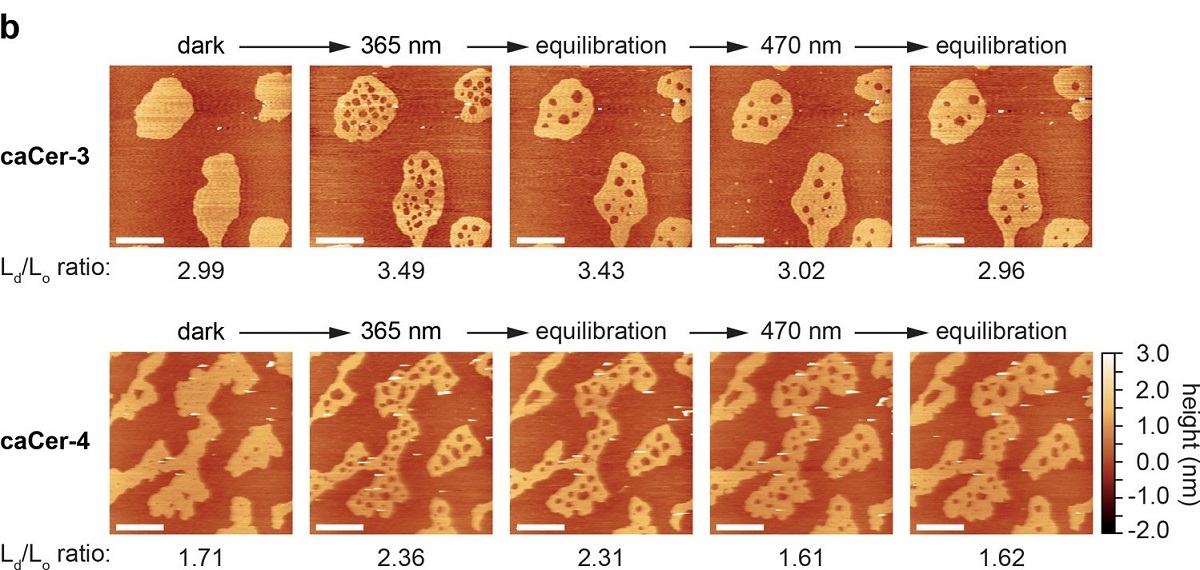N-cadherin is a transmembrane glycoprotein expressed by mesenchymal origin cells and is located at the adherens junctions. It regulates also cell motility and contributes to cell signaling.*
A pharmacological approach to inhibit N-cadherin expression or to block its function could be relevant to prevent disease progression and metastasis development.*
In the article “Molecular and nanoscale evaluation of N-cadherin expression in invasive bladder cancer cells under control conditions or GW501516 exposure” Céline Elie-Caille, Isabelle Lascombe, Adeline Péchery, Hugues Bittard and Sylvie Fauconnet, describe how they aimed at exploring the expression level of N-cadherin in invasive bladder cancer cells upon GW501516 exposure by both molecular biology techniques such as RTqPCR and Western blotting and atomic force microscopy (AFM) using an AFM tip functionalized with a monoclonal antibody directed against this adhesion molecule. *
The Atomic Force Microscope is a mighty nanoanalytical tool for studying biological samples under liquid, in pathological or physiological conditions, and at the scale of a single cell. It allows to characterize cells and their modification upon drug exposure or function alteration, in terms of cell surface topography or cell adhesion. *
The authors demonstrated for the first time, that the PPARβ/δ activator from a concentration of 15 µM decreased the full length N-cadherin at the mRNA and protein level and significantly reduced its cell surface coverage through the measurements of the interaction forces involving this adhesion molecule. *
Using atomic force microscopy the authors carried out a morphological and topographical analysis on bladder cancer cells of different histologic grade. *
AFM imaging was carried out in contact mode on fixed cells (with an applied force of 0.1 V), the QI mode was used for alive cell imaging, all in liquid. *
Force spectroscopy in force mapping was used for cadherin/anti-cadherin antibody measurement interactions and cadherin mapping on cells. *
NanoWorld Pyrex-Nitride PNP-TR triangular shaped silicon nitride cantilevers ( CB2 with a typical spring constant of 0.08 N/m ) were used.
For force mapping the AFM cantilevers were calibrated. The AFM probes, made of silicon nitride, were functionalized by 1% APTES (3-(Aminopropyl)triethoxysilane) in toluene during 2 h, washed extensively with toluene, and then with ethanol.
The second step consisted in an incubation in 0.2% glutaraldehyde solution during 10 min, followed by extensive washing with water. A naked AFM tip was used as a negative control.
The modified AFM tips were then incubated in 50 µg/mL primary antibody solution (N-cadherin GC-4 clone directed against the extracellular domain, N-cadherin 3B9 clone directed against the intracellular domain, E-cadherin HECD-1 clone directed against the extracellular domain) during 30 min, then washed with PBS 1X.
Finally, the functionalized AFM tip was saturated by incubation in 2 mg/mL RSA (rat serum albumin) solution during 30 min. *
Quantitative imaging AFM mode enabled to register more than hundred force spectroscopy curves per condition. The curves registered on cells were overlayed in order to highlight a specific pattern and the interaction peak areas were measured. *

T24 and RT4 bladder cancer cell morphology and topography. a Images from control confluent cells by phase contrast microscopy. Scale bars: 200 µm. b, c AFM images obtained on control confluent cells, after glutaraldehyde fixation, in contact mode in liquid. b AFM height images. c AFM deflection images. Scale bars: 10 µm
* Céline Elie-Caille, Isabelle Lascombe, Adeline Péchery, Hugues Bittard amd Sylvie Fauconnet
Molecular and nanoscale evaluation of N-cadherin expression in invasive bladder cancer cells under control conditions or GW501516 exposure
Molecular and Cellular Biochemistry (2020) 471:113–127
DOI: https://doi.org/10.1007/s11010-020-03771-1
Please follow this external link to read the full article: https://link.springer.com/article/10.1007/s11010-020-03771-1
Open Access : The article “Molecular and nanoscale evaluation of N-cadherin expression in invasive bladder cancer cells under control conditions or GW501516 exposure” by Céline Elie-Caille, Isabelle Lascombe, Adeline Péchery, Hugues Bittard and Sylvie Fauconnet is licensed under a Creative Commons Attribution 4.0 International License, which permits use, sharing, adaptation, distribution and reproduction in any medium or format, as long as you give appropriate credit to the original author(s) and the source, provide a link to the Creative Commons license, and indicate if changes were made. The images or other third party material in this article are included in the article’s Creative Commons license, unless indicated otherwise in a credit line to the material. If material is not included in the article’s Creative Commons license and your intended use is not permitted by statutory regulation or exceeds the permitted use, you will need to obtain permission directly from the copyright holder. To view a copy of this license, visit https://creativecommons.org/licenses/by/4.0/.


